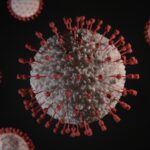
- The authors analysed the aerosol and surface stability of severe acute respiratory syndrome coronavirus (SARS-CoV) -2 and compared it to SARS-CoV-1, the most closely related human coronavirus.
- The aim of this study was to evaluate the stability of SARS-CoV-2 and SARS-CoV-1 in aerosols and different surfaces and estimate their decay rates.
Methods
- Surface stability of SARS-CoV-2 and SARS-CoV-1 were evaluated in five experimental conditions (aerosols, plastic, stainless steel, copper and cardboard). Decay rates were estimated using a Bayesian regression model.
- Aerosols (<5μm) containing both viruses were generated using a three-jet nebulizer and fed into a Goldberg drum to create an aerosolised environment.
- The inoculum produced values similar to samples obtained from upper and lower human respiratory tracts.
Results
- SARS-CoV-2 remained viable in aerosols throughout the duration of the experiment (3 hours), reducing in infectious titre from 105 to 102.7 TCID50 per litre of air (n.b. the TCID50 assay is used to determine the concentration at which 50% of virus infected cultured cells exhibit cytopathic effects). Similarly, for SARS-CoV-1, the titre reduced from 104.3 to 103.5 TCID50 per millilitre.
- SARS-CoV-2 was more stable on plastic and stainless steel than on copper and cardboard.
- Viable virus was detected up to 72 hours after application to surfaces.
- The viral titre on surfaces reduced from 107to 100.6 TCID50 per millilitre of medium after 72 hours on plastic and from 103.7 to 100.6 TCID50 per millilitre after 48 hours on stainless steel
- No viable SARS-CoV-2 was measured on copper after 4 hours and on cardboard after 24 hours.
- Both viruses demonstrated exponential decay across all experimental conditions with the half-lives of both viruses similar in aerosols, approximately 1.1-1.2 hours.
- On cardboard, the half-life of SARS-CoV-2 was longer than SARS-CoV-1 however, there was more variation in the experiment, hence the authors recommend caution when interpreting this result.
- Both viruses survived the longest on plastic (6.8 hours) and stainless steel (5.6 hours).
Conclusions
- The stability of SARS-CoV-2 was similar to that of SARS-CoV-1 under experimental circumstances
- Aerosol and fomite transmission of SARS-CoV-2 is plausible as the virus can remain viable and infectious in aerosols for hours and on surfaces for days.
Comments
This study reports on several key findings regarding SARS-CoV-2, the virus which causes COVID-19. Most notably, the virus remains viable and survives on several surfaces and in an aerosol. This adds to the body of evidence that fomite transfer is possible and aerosol generating procedures may increase the risk of virus transmission. Therefore, appropriate proactive and robust cross-infection measures are required to mitigate viral spread. It is of note that as the samples were collected from the Goldberg Drum that generated the aerosols, it is not possible to determine virus viability in relation to distance from the point of aerosol generation, type of aerosol or the duration of aerosol generating procedures. These questions would be of importance in healthcare, especially in dentistry, and more research is required in this area.
For those with an interest in the transmission dynamics of SARS-CoV-2 the Oxford Centre for Evidence-based Medicine (OCEBM) has an ongoing open systematic review ( Jefferson et al ). In addition the OECBM has two other open reviews in progress one on environmental and another onworkplace exposures as well as a general introduction to coronaviruses.
Links
Primary paper
van Doremalen, N., Bushmaker, T., Morris, D. H., Holbrook, M. G., Gamble, A., Williamson, B. N., Tamin, A., Harcourt, J. L., Thornburg, N. J., Gerber, S. I., Lloyd-Smith, J. O., de Wit, E. & Munster, V. J. (2020) Aerosol and Surface Stability of SARS-CoV-2 as Compared with SARS-CoV-1. New England Journal of Medicine, 382(16), 1564-1567.
Other references
Analysis of the Transmission Dynamics of COVID-19: An Open Evidence Review. Jefferson T, Spencer EA, Plüddemann A, Roberts N, Heneghan C.
Picture Credits
Photo by Viktor Forgacs on Unsplash

[…] News source […]
Interesting findings